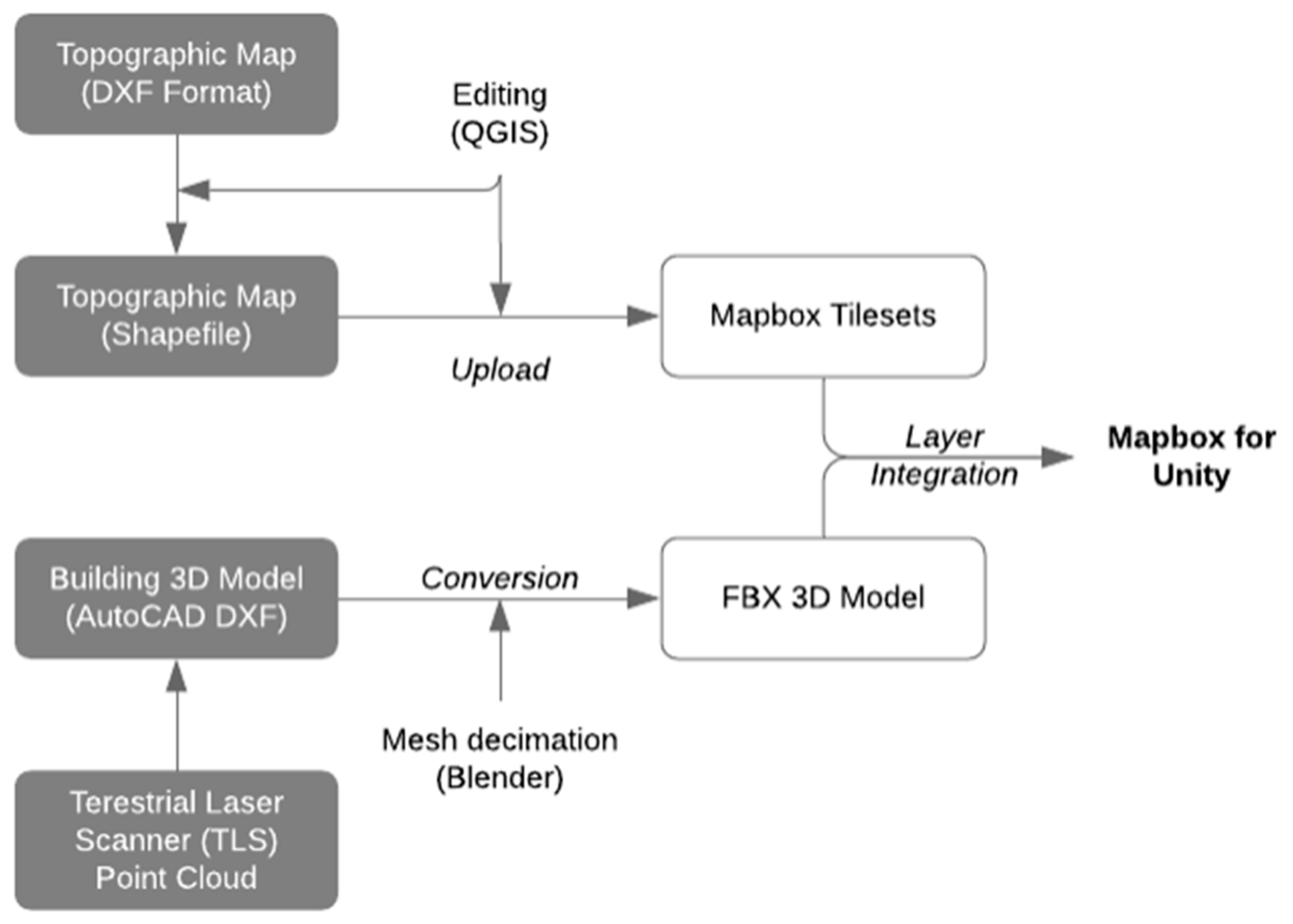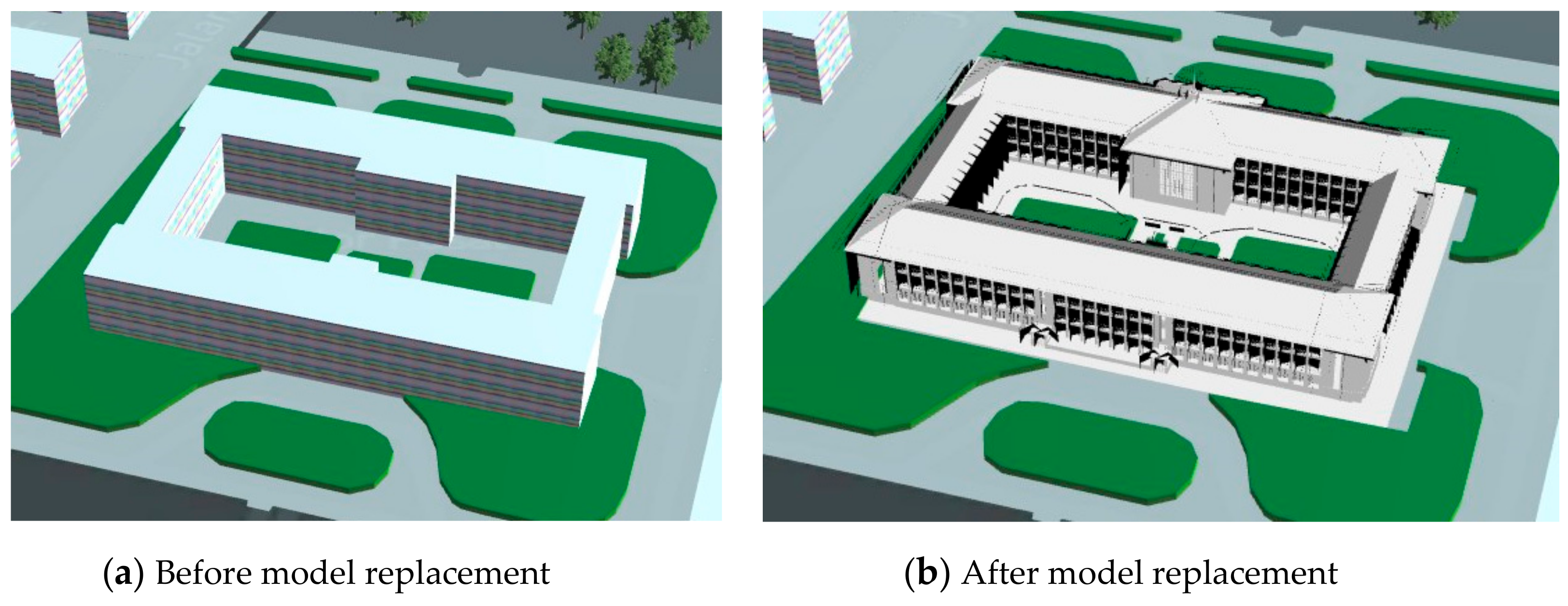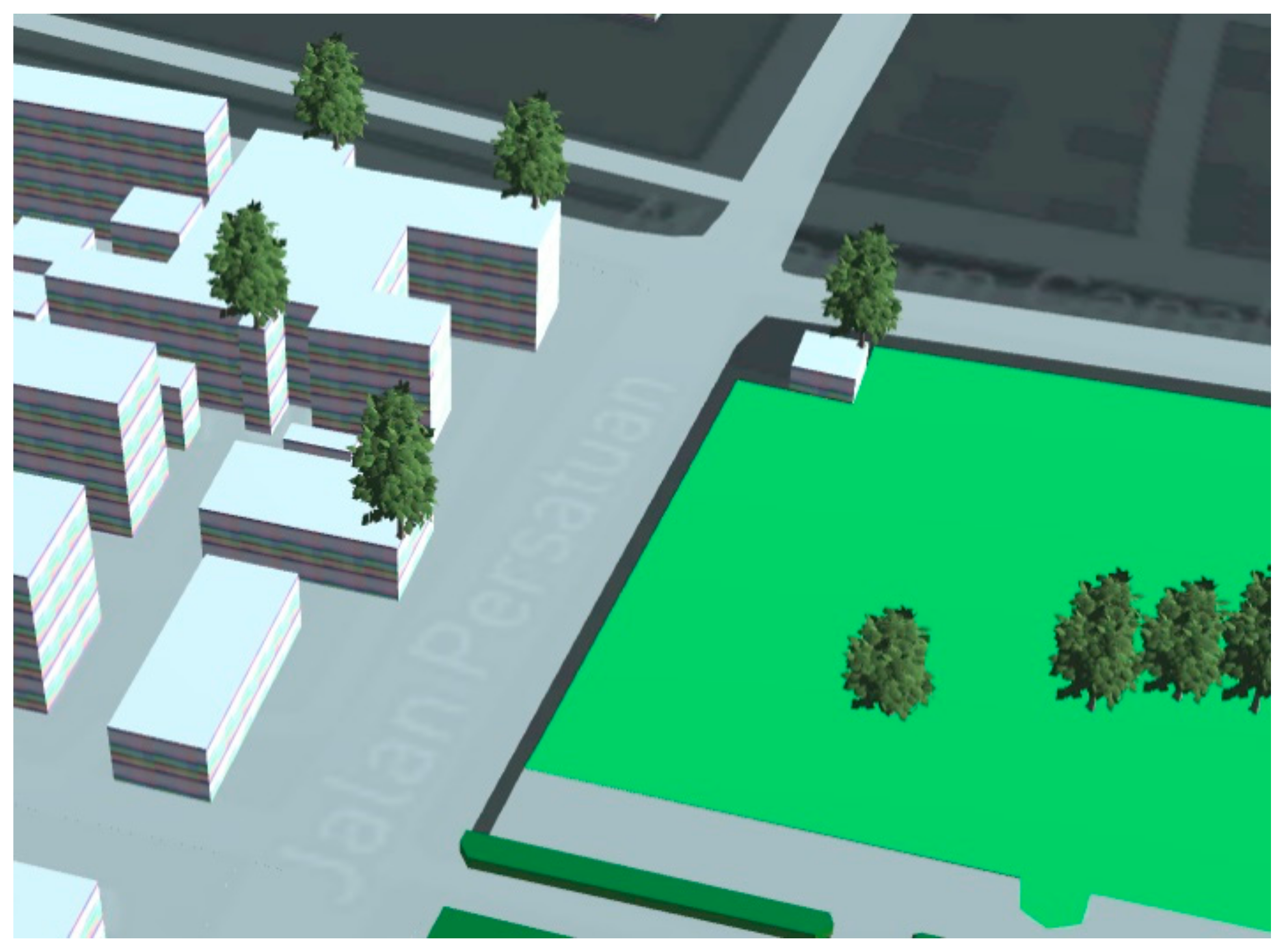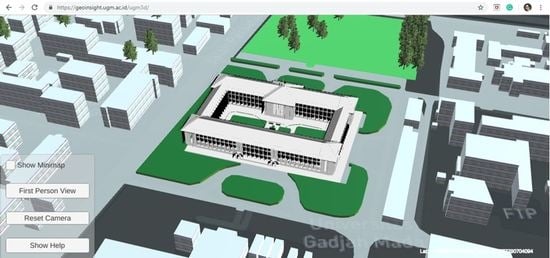Utilizing A Game Engine for Interactive 3D Topographic Data Visualization
Abstract
:1. Introduction
2. Related Works
2.1. 3D Geospatial Data Visualization
2.2. Unity Game Engine
3. Methods
3.1. Data Integration
3.2. Visual Appearances and Attributes Information
3.3. Map Interactions
- Bird Eye View. Users control the camera movements on the map, i.e., panning, rotating/tilting, look-around, and zoom in/out.
- FPV. Camera is attached to the player, where users control their movement freely.
- Drone View. The user controls a quadcopter drone to explore the scene.
4. Results
5. Discussion
6. Conclusions
Supplementary Materials
Author Contributions
Funding
Acknowledgments
Conflicts of Interest
Abbreviations
| Abbreviations | Full Text | Descriptions |
| API | Application Programming Interface | A set of routines which specifies how specific function of a software is being used |
| DXF | AutoCAD Drawing Exchange Format | A binary or an ASCII representation of a drawing file. It is often used to share drawing data between other CAD programs |
| FBX | Autodesk FilmBoX | A 3D asset exchange format that facilitates higher-fidelity 3D data exchange |
| FPV | First-Person View | An interactive visualization where the player experience virtual world through the eye of a character |
| LiDAR | Light Detection and Ranging | A remote sensing method that uses light in the form of a pulsed laser to measure ranges (variable distances) to the Earth |
| LOD | Level of Detail | A number which specifies level of 3D model representation detail [40] |
| SDK | Software Development Kit | A set of software creation tools to build application package based on certain framework |
| TLS | Terrestrial Laser Scanner | A terrestrial survey method that uses laser scanning technology to scan the object and record the 3D point-clouds, also known as topographic LiDAR |
| UGM | Universitas Gadjah Mada | University Campus in Yogyakarta, Indonesia |
Appendix A
Appendix B




References
- Farman, J. Mapping the digital empire: Google Earth and the process of postmodern cartography. New Media Soc. 2010, 12, 869–888. [Google Scholar] [CrossRef]
- Yu, L.; Gong, P. Google Earth as a virtual globe tool for Earth science applications at the global scale: Progress and perspectives. Int. J. Remote Sens. 2012, 33, 3966–3986. [Google Scholar] [CrossRef]
- Boschetti, L.; Roy, D.P.; Justice, C.O. Using NASA’s World Wind virtual globe for interactive internet visualization of the global MODIS burned area product. Int. J. Remote Sens. 2008, 29, 3067–3072. [Google Scholar] [CrossRef]
- Chaturvedi, K.; Kolbe, T.H. Dynamizers: Modeling and implementing dynamic properties for semantic 3d city models. Proc. Eurographics Work. Urban Data Model. Vis. 2015, 43–48. [Google Scholar] [CrossRef]
- Brovelli, M.A.; Minghini, M.; Moreno-sanchez, R. Free and open source software for geospatial applications (FOSS4G ) to support Future Earth. Int. J. Digit. Earth 2017, 10, 386–404. [Google Scholar] [CrossRef]
- Tully, D.; El Rhalibi, A.; Carter, C.; Sudirman, S.; Rhalibi, A. Hybrid 3D Rendering of Large Map Data for Crisis Management. ISPRS Int. J. Geo Inf. 2015, 4, 1033–1054. [Google Scholar] [CrossRef] [Green Version]
- Virtanen, J.; Hyyppä, H.; Kämäräinen, A.; Hollström, T.; Vastaranta, M.; Hyyppä, J. Intelligent Open Data 3D Maps in a Collaborative Virtual World. ISPRS Int. J. Geo Inf. 2015, 4, 837–857. [Google Scholar] [CrossRef] [Green Version]
- Lin, H.; Chen, M.; Lu, G. Virtual Geographic Environment: A Workspace for Computer-Aided Geographic Experiments. Ann. Assoc. Am. Geogr. 2013, 103, 465–482. [Google Scholar] [CrossRef]
- Trenholme, D.; Smith, S.P. Computer game engines for developing first-person virtual environments. Virtual Real. 2008, 12, 181–187. [Google Scholar] [CrossRef] [Green Version]
- Natephra, W.; Motamedi, A.; Fukuda, T.; Yabuki, N. Integrating building information modeling and virtual reality development engines for building indoor lighting design. Vis. Eng. 2017, 5, 21. [Google Scholar] [CrossRef]
- Rua, H.; Alvito, P. Living the past: 3D models, virtual reality and game engines as tools for supporting archaeology and the reconstruction of cultural heritage e the case-study of the Roman villa of Casal de Freiria. J. Archaeol. Sci. 2011, 38, 3296–3308. [Google Scholar] [CrossRef]
- Indraprastha, A.; Shinozaki, M. The Investigation on Using Unity3D Game Engine in Urban Design Study. ITB J. Inf. Commun. Technol. 2009, 3, 1–18. [Google Scholar] [CrossRef] [Green Version]
- Rafiee, A.; Van Der Male, P.; Dias, E.; Scholten, H. Interactive 3D geodesign tool for multidisciplinary wind turbine planning. J. Environ. Manag. 2018, 205, 107–124. [Google Scholar] [CrossRef] [PubMed]
- Trubka, R.; Glackin, S.; Lade, O.; Pettit, C. A web-based 3D visualisation and assessment system for urban precinct scenario modelling. ISPRS J. Photogramm. Remote Sens. 2016, 117, 175–186. [Google Scholar] [CrossRef]
- Susi, T.; Johannesson, M.; Backlund, P. Serious Games: An Overview; Institutionen för kommunikation och information: Skövde, Sweden, 2007. [Google Scholar]
- Wahyudin, D.; Hasegawa, S. The Role of Serious Games in Disaster and Safety Education: An Integrative Review. In Proceedings of the 25th International Conference on Computers in Education; Asia-Pacific Society for Computers in Education: Christchurch, New Zealand, 2017; pp. 180–190. [Google Scholar]
- Aditya, T.; Laksono, D. Geogame on the peat: Designing effective gameplay in geogames app for haze mitigation. Int. Arch. Photogramm. Remote Sens. Spat. Inf. Sci. 2018, 42, 5–10. [Google Scholar] [CrossRef]
- Mat, R.C.; Shariff, A.R.M.; Zulkifli, A.N.; Rahim, M.S.M.; Mahayudin, M.H. Using game engine for 3D terrain visualisation of GIS data: A review. IOP Conf. Ser. Earth Environ. Sci. 2014, 20, 012037. [Google Scholar] [CrossRef]
- Reyes, M.E.P.; Chen, S.C. A 3D Virtual Environment for Storm Surge Flooding Animation. In Proceedings of the 2017 IEEE Third International Conference on Multimedia Big Data (BigMM), Laguna Hills, CA, USA, 19–21 April 2017; pp. 244–245. [Google Scholar]
- Evangelidis, K.; Papadopoulos, L.; Papatheodorou, K.; Mastorokostas, P.; Hilas, C. Geospatial Visualizations: Animation and Motion Effects on Spatial Objects. Comput. Geosic. 2018, 111, 200–212. [Google Scholar] [CrossRef]
- Thöny, M.; Schnürer, R.; Sieber, R.; Hurni, L.; Pajarola, R. Storytelling in Interactive 3D Geographic Visualization Systems. ISPRS Int. J. Geo Inf. 2018, 7, 123. [Google Scholar] [CrossRef]
- Tsai, Y.T.; Jhu, W.Y.; Chen, C.C.; Kao, C.H.; Chen, C.Y. Unity game engine: Interactive software design using digital glove for virtual reality baseball pitch training. Microsyst. Technol. 2019, 9, 1–17. [Google Scholar] [CrossRef]
- Alatalo, T.; Pouke, M.; Koskela, T.; Hurskainen, T.; Florea, C.; Ojala, T. Two real-world case studies on 3D web applications for participatory urban planning. In Proceedings of the 22nd International Conference on 3D Web Technology, Brisbane, Australia, 5–7 June 2017. [Google Scholar]
- Lee, W.L.; Tsai, M.H.; Yang, C.H.; Juang, J.R.; Su, J.Y. V3DM+: BIM interactive collaboration system for facility management. Vis. Eng. 2016, 4, 5. [Google Scholar] [CrossRef]
- Dutton, C. Correctly and accurately combining normal maps in 3D engines. Comput. Games J. 2013, 2, 41–54. [Google Scholar] [CrossRef]
- Julin, A.; Jaalama, K.; Virtanen, J.P.; Pouke, M.; Ylipulli, J.; Vaaja, M.; Hyyppa, J.; Hyyppä, H. Characterizing 3D City Modeling Projects: Towards a Harmonized Interoperable System. ISPRS Int. J. Geo Inf. 2018, 7, 55. [Google Scholar] [CrossRef]
- Petridis, P.; Dunwell, I.; Panzoli, D.; Arnab, S.; Protopsaltis, A.; Hendrix, M.; Freitas, S.; De Freitas, S. Game Engines Selection Framework for High-Fidelity Serious Applications. Int. J. Interact. Worlds 2012, 2012, 1–19. [Google Scholar] [CrossRef]
- Bayburt, S.; Baskaraca, A.P.; Karim, H.; Rahman, A.A.; Buyuksalih, I. 3D Modelling And Visualization Based On The Unity Game Engine—Advantages And Challenges. ISPRS Ann. Photogramm. Remote. Sens. Spat. Inf. Sci. 2017, W4, 161–166. [Google Scholar]
- Unity3D. Skybox Series. 2019. Available online: https://assetstore.unity.com/packages/2d/textures-materials/sky/skybox-series-free-103633 (accessed on 28 March 2019).
- Unity3D. Unity Scripting API: Physics Raycast. Available online: https://docs.unity3d.com/ScriptReference/Physics.Raycast.html (accessed on 12 May 2019).
- Unity3D. Unity3D Standard Assets. 2019. Available online: https://assetstore.unity.com/packages/essentials/asset-packs/standard-assets-32351 (accessed on 19 March 2019).
- Aditya, T.; Laksono, D.; Sutanta, H.; Izzahudin, N.; Susanta, F. A usability evaluation of a 3d map display for pedestrian navigation. ISPRS Int. Arch. Photogramm. Remote Sens. Spat. Inf. Sci. 2018, 42, 3–10. [Google Scholar] [CrossRef]
- Liao, H.; Dong, W. An Exploratory Study Investigating Gender Effects on Using 3D Maps for Spatial Orientation in Wayfinding. ISPRS Int. J. Geo Inf. 2017, 6, 60. [Google Scholar] [CrossRef]
- Liao, H.; Dong, W.; Peng, C.; Liu, H. Exploring differences of visual attention in pedestrian navigation when using 2D maps and 3D. Cartogr. Geogr. Inf. Sci. 2017, 44, 474–490. [Google Scholar] [CrossRef]
- Halik, Ł. Challenges in Converting the Polish Topographic Database of Built-Up Areas into 3D Virtual Reality Geovisualization. Cartogr. J. 2018, 55, 391–399. [Google Scholar] [CrossRef]
- Bakri, H.; Allison, C. Measuring QoS in web-based virtual worlds. In Proceedings of the 8th International Workshop on Massively Multiuser Virtual Environments, Klagenfurt, Austria, 10–13 May 2016; pp. 1–6. [Google Scholar]
- Belussi, A.; Migliorini, S. A Framework for Integrating Multi-accuracy Spatial Data in Geographical Applications. Geoinformatica 2012, 16, 523–561. [Google Scholar] [CrossRef]
- Caquard, S.; Cartwright, W. Narrative Cartography: From Mapping Stories to the Narrative of Maps and Mapping. Cartogr. J. 2014, 51, 101–106. [Google Scholar] [CrossRef]
- Cartwright, W.; Field, K. Exploring Cartographic Storytelling. Reflections on Mapping Real-life and Fictional Stories. In Proceedings of the International Cartographic Conference, Rio de Janeiro, Brazil, 23–28 August 2015. [Google Scholar]
- Biljecki, F.; LeDoux, H.; Stoter, J. An improved LOD specification for 3D building models. Comput. Environ. Urban Syst. 2016, 59, 25–37. [Google Scholar] [CrossRef] [Green Version]













| Layer | Texture | Custom Modifiers |
|---|---|---|
| Buildings 1 | Mapbox top and side material | Highlight building on mouse-over Display building’s attributes Replace building with 3D model Set colliders |
| Roads | Mapbox light color with transparency | Remove colliders |
| Parks | Custom color (light green) | Remove colliders |
| City Forests | Custom color (green) | Spawn 3D tree model Set collider for trees |
| Fields | Custom color (brown) | Remove colliders |
| Contours | Custom color (light brown) | Remove colliders |
© 2019 by the authors. Licensee MDPI, Basel, Switzerland. This article is an open access article distributed under the terms and conditions of the Creative Commons Attribution (CC BY) license (http://creativecommons.org/licenses/by/4.0/).
Share and Cite
Laksono, D.; Aditya, T. Utilizing A Game Engine for Interactive 3D Topographic Data Visualization. ISPRS Int. J. Geo-Inf. 2019, 8, 361. https://doi.org/10.3390/ijgi8080361
Laksono D, Aditya T. Utilizing A Game Engine for Interactive 3D Topographic Data Visualization. ISPRS International Journal of Geo-Information. 2019; 8(8):361. https://doi.org/10.3390/ijgi8080361
Chicago/Turabian StyleLaksono, Dany, and Trias Aditya. 2019. "Utilizing A Game Engine for Interactive 3D Topographic Data Visualization" ISPRS International Journal of Geo-Information 8, no. 8: 361. https://doi.org/10.3390/ijgi8080361
APA StyleLaksono, D., & Aditya, T. (2019). Utilizing A Game Engine for Interactive 3D Topographic Data Visualization. ISPRS International Journal of Geo-Information, 8(8), 361. https://doi.org/10.3390/ijgi8080361







